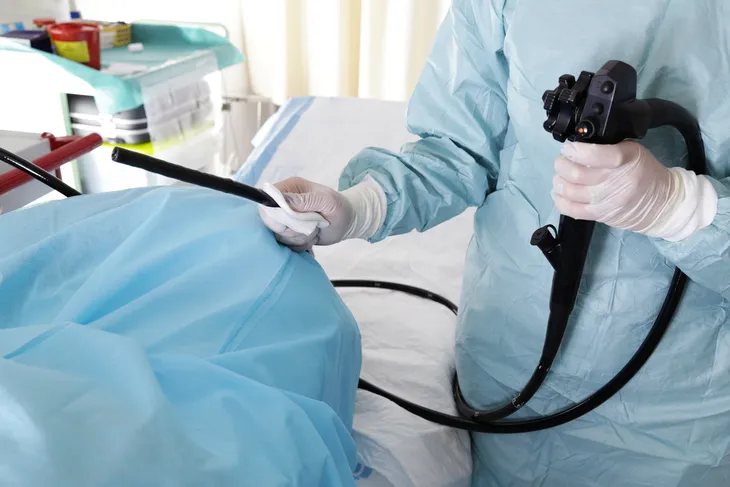There are some health screening tests every man should get – because there’s nothing manly about developing diseases, especially if you have risk factors based on your lifestyle or family history.
Screening is designed to catch health problems before they develop into a bigger problem, and in many cases, you’ll have no idea there’s trouble brewing until you’re sick enough to see a doctor. Think of this as similar to preventative maintenance on your truck, which is always easier than a repair. So here are 12 important screening tests for men…
Colon Check
No one likes the thought of having a tube inserted into their colon, but the alternative – namely colorectal cancer – is much, much worse. WebMD notes that screening for colorectal cancer begins at age 50 for “average-risk” adults.
Using a flexible tube equipped with a camera in a procedure colonoscopy, a doctor can examine the entire length of the colon and search for abnormal growths called polyps – which can also be removed at the same time, notes the source. There’s a slightly less intensive version called a flexible sigmoidoscopy that only detects problems in the lower third of the colon, it adds.
Exams are Flexible
With regard to flexible sigmoidoscopy, MedicineNet.com explains the tube is about 60-centimeters (24-inches) in length and the “thickness of your little finger.” It’s slowly inserted into the anus and generally used to find the cause of rectal bleeding or change in bowel habits, adds the source.
The procedure is quick, as fast as 5-minutes, and there’s usually minimal discomfort involved. You’ll be awake during the procedure and carry on with your day almost immediately afterwards, whereas with a colonoscopy it’s generally recommended to have a ride home due to sedation.
The Eyes Have It
Glaucoma is a condition that affects the eyes of many men, especially as they progress in age. There are different types of glaucoma, but generally it relates to high pressure in the eye that causes damage to the optic nerve – and it doesn’t present any early symptoms, says AllAboutVision.com.
An eye doctor (optometrist or ophthalmologist) can screen for signs of glaucoma during a routine eye exam, using an instrument called a tonometer, which measures the pressure within your eye. In many cases, a puff of air is used to measure the pressure, while another method uses numbing eye drops and a probe that rests gently against the surface of your eye, explains the source.
Don’t Ignore the Prostate
The prostate gland is specific to men (although women have the Skene’s gland, which produces the same protein markers as the male prostate), and therefore problems associated with the prostate are also specific to men. In fact, prostate cancer is the leading cancer in males.
There’s a screening test for this form of cancer called the prostate-specific antigen (PSA), which measures the levels of this antigen in men’s blood, explains the National Cancer Institute. Elevated levels can be associated with prostate cancer, it adds, and this test can also monitor the progression of the disease. This is not the only method of screening for prostate cancer, as we’ll get to next.
Digital Detection
Unfortunately, as the name may suggest, a digital rectal exam isn’t an electronic scan to test for prostate cancer. It refers to the insertion of a digit (more specifically, your doctor’s gloved finger) into your rectum (which is in very close proximity to your prostate gland) to feel around for any abnormalities.
WebMD calls it a “relatively simple” screening test for prostate cancer because the prostate is located in the front of your rectum. Your doctor will search for hard or lumpy areas that aren’t normal, and you may experience some slight discomfort during the screening procedure. However, it won’t interfere with your day. While age 50 is generally when prostate cancer screening discussions begin, interestingly not all medical institutions are in agreement that a digital exam is necessary, it adds.
Take a Deep Breath
While prostate cancer is the most commonly diagnosed cancer in males, lung cancer is the deadliest among males, and smoking is a big reason for this, notes WebMD. If you are an adult aged 55 to 80 years and have been smoking for a long time (the equivalent of a pack a day for 30-years) or you have quit smoking cigarettes within the past 15 years, there is a screening test for lung cancer you should definitely get.
Doctors will perform a low-dose computed tomography (LDCT) scan, which is a fancy way to say an X-ray of your lungs. During the test, you’ll have to raise your arms over your head and hold your breath for up to 10-seconds, but other than that, it’s pretty simple. Talk to your doctor about getting these scans beginning at age 55, even if you don’t smoke.
Beyond the Surface
Men’s Health says that men (and women) should consider getting an annual skin cancer exam, thanks to the depletion of the earth’s ozone layer that once protected people more from dangerous ultraviolet (UV) sun rays.
This is not a disease that’s exclusive to older adults, as sun-worshipping people in their teens, 20s and 30s should also be checked, and stats show that skin cancer is the leading cause of disease-related death for Americans under age 40, notes the source. A skin doctor (dermatologist) will look for any abnormalities and use a biopsy to examine skin tissue if necessary.
Testing the Testes
The testicles (or testes) are also exclusive to men and are quite prone to cancer as well. The National Cancer Institute says there’s actually no standard or routine screening test for early detection of this form of cancer, but the warning signs can be found through self-exams or a doctor-led physical exam.
The telltale sign of testicular cancer is a lump, which can be checked for cancer cells. Testicular cancer “can usually be cured at any stage,” but finding it early can make it easier to treat and prevent it from spreading to other parts of the body (a process known as metastasis), it adds.
Get Pressured into Screening
High blood pressure (or hypertension) is a problem that plagues many men in the U.S., but it usually has no signs at all until a health episode such as a heart attack or stroke, giving it the “silent killer” nickname.
Luckily, checking your blood pressure is a pretty simple and quick test, which you can start at age 20 (at least every 2-years) if the reading is lower than 120/80 mm Hg, says the American Heart Association. If your blood pressure is higher, then you should get it checked more regularly. Lifestyle changes (diet and exercise) and some medications can help keep it under control, it adds.
Cholesterol Checks
The same source explains that a fasting lipid panel can screen for low-density lipoprotein (LDL), also known as “bad” cholesterol (while also measuring how much high-density lipoprotein (HDL) or “good” cholesterol) you have in your blood. Unhealthy levels of cholesterol can cause plaque buildup in arteries that leads to complications, such as heart attacks and strokes.
The source says you can start getting this test at age 20, and then every 4 to 6-years following the initial screening – unless it’s determined you’re at higher risk for cardiovascular events, which means more frequent checks. “Like high blood pressure, cholesterol can often be controlled through lifestyle changes and/or medication,” adds the source.
Detecting Diabetes
This is another disease that affects many men in the U.S., and it’s among the leading killers in the country. MedicinePlus.gov says you should be screened for type 2 diabetes every 3-years starting at age 45.
The source says if your blood pressure is above 135/80 mmHg, or you “have other risk factors for diabetes,” then your doctor might want to screen your blood sugar levels earlier than age 45. Obesity is a big risk factor for hypertension, so if you’re overweight, talk with your doctor about being screened earlier than age 45. Meanwhile, Asian Americans should be screened if their BMI is ≥ 23 kg/m2.
HIV Checks
If you have human immunodeficiency virus (HIV), you may not have any symptoms at all and unwittingly pass it on to others through sexual contact or broken skin, explains WebMD. HIV can develop into full-blown deadly acquired immunodeficiency syndrome (AIDS).
While there’s no cure or vaccine for HIV, getting screened can help you get treatment to keep it at bay (and arm you with the knowledge that you have it). The source says the initial test is called an enzyme-linked immunosorbent assay (ELISA) or enzyme immunoassay (EIA), which looks for related antibodies in the blood. “It’s possible not to be infected and still show a positive on the test,” it notes, so another test called a Western blot assay is required for a diagnosis. Both tests may be negative if you were just recently infected.















